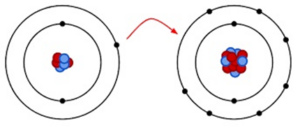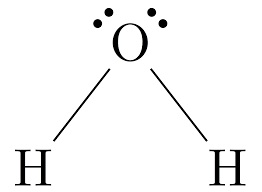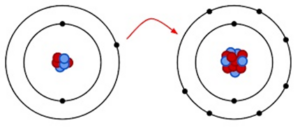Sodium carbonate, also known as soda ash or washing soda, is an ionic compound. It is composed of sodium ions (Na+) and carbonate ions (CO3^2-). The sodium ion has a positive charge, while the carbonate ion has a negative charge. These ions are held together by strong electrostatic forces of attraction, forming an ionic bond. Sodium carbonate is highly soluble in water and dissociates into its constituent ions, allowing it to conduct electricity. It is commonly used in various industries, including glass manufacturing, water treatment, and as a cleaning agent.
Key Takeaways
| Property | Value |
|---|---|
| Chemical Formula | Na2CO3 |
| Molar Mass | 105.99 g/mol |
| Melting Point | 851 °C |
| Boiling Point | Decomposes at 1,600 °C |
| Solubility | Highly soluble in water |
| Conductivity | Good conductor of electricity |
Understanding Basic Chemistry Concepts
Chemistry is the study of matter and its properties, as well as the changes it undergoes. It helps us understand the composition, structure, and behavior of substances. In this article, we will explore some fundamental concepts in chemistry, including the difference between ionic and covalent compounds, anhydrous sodium carbonate, and the formation of carbonate ions.
Difference between Ionic and Covalent Compound

Ionic compounds and covalent compounds are two types of chemical compounds with distinct characteristics.
Ionic compounds are formed through the transfer of electrons between atoms. This transfer creates positively charged ions (cations) and negatively charged ions (anions). The opposite charges attract each other, resulting in the formation of an ionic bond. Sodium carbonate (Na2CO3) is an example of an ionic compound. It consists of sodium ions (Na+) and carbonate ions (CO3^2-). Ionic compounds tend to have high melting and boiling points, and they often dissolve in water to form electrolytes.
Covalent compounds, on the other hand, are formed through the sharing of electrons between atoms. In covalent bonding, atoms share electron pairs to achieve a stable electron configuration. Covalent compounds can be either molecular or network solids. Molecular covalent compounds, such as carbon dioxide (CO2), consist of discrete molecules held together by covalent bonds. Network covalent compounds, like diamond, have a continuous network of covalent bonds throughout the structure. Covalent compounds generally have lower melting and boiling points compared to ionic compounds.
What is Meant by Anhydrous Sodium Carbonate?
Anhydrous sodium carbonate refers to sodium carbonate (Na2CO3) that does not contain any water molecules. Sodium carbonate is a white, crystalline solid commonly known as soda ash or washing soda. It has various applications in industries such as glass manufacturing, detergent production, and water treatment.
When sodium carbonate is anhydrous, it means that it does not have any water molecules attached to its crystal structure. Anhydrous sodium carbonate is often used as a drying agent because it has a strong affinity for water. It can absorb moisture from the air, making it useful in removing water from certain substances or environments.
How is Carbonate Ion Formed?
The carbonate ion (CO3^2-) is formed through the combination of carbon dioxide (CO2) and water (H2O). This reaction occurs in aqueous solutions and is influenced by the pH of the solution.
In an aqueous solution with a high pH (alkaline conditions), carbon dioxide reacts with water to form bicarbonate ions (HCO3^-). The bicarbonate ions can further react with water to form carbonate ions:
CO2 + H2O ⇌ HCO3^- + H+
HCO3^- + H2O ⇌ CO3^2- + H+
In alkaline conditions, the concentration of carbonate ions increases, leading to the formation of the carbonate ion.
The carbonate ion plays a crucial role in various chemical processes. It is involved in the formation of minerals like limestone and coral reefs. Additionally, carbonate ions are essential in maintaining the pH balance in natural waters and buffering acidic conditions.
Sodium Carbonate: An In-depth Look
Sodium carbonate, also known as soda ash or washing soda, is a chemical compound with the formula Na2CO3. It is a white, crystalline solid that is commonly used in various industries due to its versatile properties. In this article, we will explore the sodium carbonate Lewis structure, its ionic formula, the process of its production, and its common uses.
Sodium carbonate Lewis structure
The Lewis structure of sodium carbonate illustrates the arrangement of atoms and their bonding in the compound. Sodium carbonate (Na2CO3) consists of two sodium ions (Na+) and one carbonate ion (CO3^2-). The sodium ions each donate one electron to the carbonate ion, resulting in the formation of ionic bonds. This ionic bonding is responsible for the compound’s stability and characteristic properties.
Sodium carbonate ionic formula
The ionic formula of sodium carbonate, Na2CO3, represents the ratio of ions present in the compound. The subscript 2 indicates that there are two sodium ions for every carbonate ion. This formula helps us understand the composition of sodium carbonate and its behavior in chemical reactions.
Sodium carbonate process: How is sodium carbonate made?
Sodium carbonate is primarily produced through a process called the Solvay process. This method involves several steps, including the extraction of sodium chloride (NaCl) from salt deposits or seawater. The sodium chloride is then reacted with ammonia (NH3) and carbon dioxide (CO2) to form sodium bicarbonate (NaHCO3). Finally, the sodium bicarbonate is heated to produce sodium carbonate.
What is sodium carbonate commonly known as?
Sodium carbonate is commonly known as soda ash or washing soda. These names reflect its historical use in household cleaning products and laundry detergents. However, sodium carbonate has a wide range of applications beyond cleaning. Let’s explore some of its common uses.
-
Glass manufacturing: Sodium carbonate is a key ingredient in glass production. It helps to lower the melting point of silica, allowing for easier shaping and molding of glass. It also improves the clarity and durability of glass products.
-
Dyeing and textile industry: Sodium carbonate is used in the dyeing process of fabrics. It helps to fix dyes onto the fibers, ensuring vibrant and long-lasting colors. It also acts as a pH regulator, maintaining the optimal pH level for dyeing.
-
Food industry: Sodium carbonate, or food-grade soda ash, is used in various culinary applications. It is used in the production of certain types of food additives, such as leavening agents and food colorings. It is also used in the preparation of traditional dishes and baked goods.
-
Water treatment: Sodium carbonate is used in water treatment processes to adjust pH levels and remove impurities. It can help to neutralize acidic water and improve its quality for consumption or industrial use.
-
pH regulator: Sodium carbonate is commonly used as a pH regulator in various industries. Its alkaline nature allows it to neutralize acidic substances and maintain a stable pH level in different processes.
Is Sodium Carbonate Ionic or Covalent?

Why Sodium carbonate is not a covalent compound?
When we talk about the nature of chemical compounds, we often categorize them as either ionic or covalent. Sodium carbonate, with its chemical formula Na2CO3, falls into the category of ionic compounds rather than covalent compounds. This is because of the way its atoms are bonded together.
In a covalent compound, atoms share electrons to form bonds. However, in the case of sodium carbonate, the bonding is not based on the sharing of electrons. Instead, it involves the transfer of electrons from one atom to another.
Is sodium carbonate an ionic compound?
Yes, sodium carbonate is indeed an ionic compound. It is composed of sodium ions (Na+) and carbonate ions (CO3^2-). The sodium ions have a positive charge, while the carbonate ions have a negative charge. The attraction between these oppositely charged ions forms the basis of the ionic bond in sodium carbonate.
Why is sodium carbonate ionic?
The ionic nature of sodium carbonate can be attributed to the electronegativity difference between sodium and carbonate. Sodium, being a metal, has a low electronegativity, while carbonate, being a polyatomic ion, has a higher electronegativity. This difference in electronegativity leads to the transfer of electrons from sodium to carbonate, resulting in the formation of ions.
Is sodium carbonate ionic or molecular?
Sodium carbonate is an ionic compound, not a molecular compound. Molecular compounds are formed when atoms share electrons in covalent bonds. In the case of sodium carbonate, the bonding involves the complete transfer of electrons, resulting in the formation of ions. Therefore, sodium carbonate is classified as an ionic compound.
Ionic compounds, like sodium carbonate, have distinct characteristics. They tend to have high melting and boiling points, are often soluble in water, and can conduct electricity when dissolved or molten due to the presence of ions. Sodium carbonate, for example, readily dissolves in water to form a solution that can conduct electricity.
Overall, the ionic nature of sodium carbonate plays a significant role in its chemical properties and applications. It is widely used in various industries, including glass manufacturing, dye production, and as a pH regulator in cuisine. The formation of ionic bonds in sodium carbonate allows it to maintain its stability and perform its desired functions effectively.
Sodium Carbonate in Action
Sodium carbonate, also known as Na2CO3, is an ionic compound that plays a significant role in various chemical reactions and applications. Let’s explore some of the interesting properties and reactions of sodium carbonate.
What happens when sodium carbonate reacts with acid?
When sodium carbonate reacts with an acid, such as hydrochloric acid (HCl), a chemical reaction occurs. The sodium carbonate reacts with the acid to produce carbon dioxide (CO2), water (H2O), and a salt. This reaction is commonly used in industries for neutralizing acidic solutions and in household cleaning products.
What happens when sodium carbonate dissolves in water?
Sodium carbonate is highly soluble in water. When it dissolves in water, it dissociates into sodium ions (Na+) and carbonate ions (CO3^2-). This dissociation allows sodium carbonate to effectively interact with other substances in solution, making it useful in various applications such as water treatment and pH regulation.
Does sodium carbonate conduct electricity?
As an ionic compound, sodium carbonate can conduct electricity when dissolved in water or in a molten state. The presence of charged ions in the solution allows for the flow of electric current. However, solid sodium carbonate does not conduct electricity as the ions are not free to move.
Does sodium carbonate increase alkalinity?
Yes, sodium carbonate is an alkaline compound and can increase the alkalinity of a solution. When sodium carbonate dissolves in water, it releases hydroxide ions (OH-) which can react with acidic substances, thereby increasing the pH and alkalinity of the solution. This property makes sodium carbonate useful in applications such as pH adjustment in swimming pools and water treatment processes.
Is sodium carbonate an oxidizing agent?
Sodium carbonate is not considered an oxidizing agent. It does not readily donate oxygen or accept electrons from other substances. Instead, it primarily acts as a base or a pH regulator in various chemical reactions.
Does sodium carbonate increase pH?
Yes, sodium carbonate can increase the pH of a solution. When dissolved in water, it releases hydroxide ions (OH-) which can react with hydrogen ions (H+) from acidic substances, resulting in an increase in pH. This property makes sodium carbonate useful in applications where pH adjustment is required, such as in the production of certain dyes and in culinary processes.
Frequently Asked Questions (FAQ)
What is sodium carbonate and sodium bicarbonate?
Sodium carbonate and sodium bicarbonate are both chemical compounds that contain sodium, carbon, and oxygen. They have different chemical formulas and properties.
Sodium carbonate, with the chemical formula Na2CO3, is an ionic compound. It is commonly known as soda ash or washing soda. Sodium carbonate is a white, crystalline solid that is highly soluble in water. It is often used in various industries, such as glass manufacturing, detergent production, and water treatment. Sodium carbonate is also used as a pH regulator in swimming pools and as a food additive in certain culinary processes.
On the other hand, sodium bicarbonate, with the chemical formula NaHCO3, is also an ionic compound. It is commonly known as baking soda. Sodium bicarbonate is a white, crystalline powder that is also soluble in water. It is widely used in baking as a leavening agent, as well as in various household cleaning products and personal care items.
How to find sodium carbonate ionic compound?
To identify sodium carbonate as an ionic compound, we can examine its chemical formula and the elements it contains. Sodium carbonate, Na2CO3, consists of sodium ions (Na+) and carbonate ions (CO3^2-). Ionic compounds are formed when a metal (in this case, sodium) reacts with a non-metal (carbonate). The presence of ions in the formula indicates that sodium carbonate is an ionic compound.
What is sodium carbonate used for?
Sodium carbonate has a wide range of applications in various industries. Some common uses of sodium carbonate include:
-
Glass Manufacturing: Sodium carbonate is a key ingredient in the production of glass. It helps to lower the melting point of silica, allowing it to be shaped into glassware, bottles, and windows.
-
Detergent Production: Sodium carbonate is a vital component in many laundry and dishwashing detergents. It helps to remove stains and neutralize acidic substances, improving the cleaning efficiency.
-
Water Treatment: Sodium carbonate is used in water treatment processes to adjust the pH levels and remove impurities. It helps to precipitate out certain metals and improve the quality of drinking water.
-
pH Regulation: Sodium carbonate is commonly used as a pH regulator in swimming pools. It helps to maintain the desired pH level, ensuring the water is safe and comfortable for swimmers.
-
Culinary Processes: Sodium carbonate is used in certain culinary processes, such as pretzel making and noodle production. It helps to give these food items a unique texture and appearance.
Why is sodium hydrogen carbonate an ionic compound?
Sodium hydrogen carbonate, also known as sodium bicarbonate, is an ionic compound due to the presence of ions in its chemical formula (NaHCO3). It contains sodium ions (Na+) and bicarbonate ions (HCO3^-). The formation of ionic bonds occurs when a metal (sodium) reacts with a polyatomic ion (bicarbonate). The transfer of electrons between these elements results in the formation of an ionic compound.
Ionic compounds, like sodium hydrogen carbonate, have distinct characteristics. They are typically solid at room temperature, have high melting and boiling points, and are soluble in water. These compounds conduct electricity when dissolved in water or melted, due to the movement of ions. Sodium hydrogen carbonate is widely used in baking, cleaning, and various other applications due to its unique properties.
Frequently Asked Questions
What is the structure of Sodium carbonate?
The structure of Sodium carbonate (Na2CO3) is ionic. It consists of two sodium ions (Na+) and one carbonate ion (CO3-2). The sodium ions are positively charged, while the carbonate ion is negatively charged. These ions are held together by ionic bonds.
Is Sodium carbonate an ionic or covalent compound?
Sodium carbonate is an ionic compound. It is composed of sodium ions (Na+) and carbonate ions (CO3-2), which are held together by ionic bonds. Unlike covalent compounds, which share electrons, ionic compounds transfer electrons from one atom to another.
What is the chemical formula for Sodium carbonate?
The chemical formula for Sodium carbonate is Na2CO3. This formula indicates that there are two sodium ions (Na+) for every one carbonate ion (CO3-2) in the compound.
How does Sodium carbonate react with water?
When Sodium carbonate dissolves in water, it dissociates into its constituent ions: two sodium ions (Na+) and one carbonate ion (CO3-2). This reaction increases the pH of the water, making it more alkaline.
What are the uses of Sodium carbonate?
Sodium carbonate is commonly used in various industries such as glass manufacturing, paper production, and soap making. It is also used as a water softener in laundry detergents and as a pH regulator in swimming pools.
How is Sodium carbonate produced?
Sodium carbonate is typically produced through the Solvay process. This involves the reaction of sodium chloride (salt) and ammonia, which produces sodium bicarbonate (baking soda). The sodium bicarbonate is then heated to produce sodium carbonate.
Is Sodium carbonate an oxidizing agent?
No, Sodium carbonate is not an oxidizing agent. It is a type of salt that can act as a mild alkali when dissolved in water.
Does Sodium carbonate increase the pH of a solution?
Yes, when Sodium carbonate is dissolved in water, it dissociates into sodium ions and carbonate ions. The carbonate ions can accept hydrogen ions (H+) from water, forming bicarbonate ions and thereby increasing the pH of the solution.
What is the ionic formula for Sodium carbonate?
The ionic formula for Sodium carbonate is Na2CO3. This indicates that the compound consists of two sodium ions (Na+) and one carbonate ion (CO3-2).
Can Sodium carbonate conduct electricity?
In its solid state, Sodium carbonate does not conduct electricity. However, when dissolved in water or melted, it can conduct electricity. This is because the ions are free to move and carry electrical charge.
Also Read:
